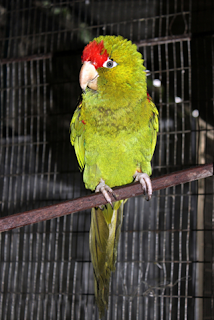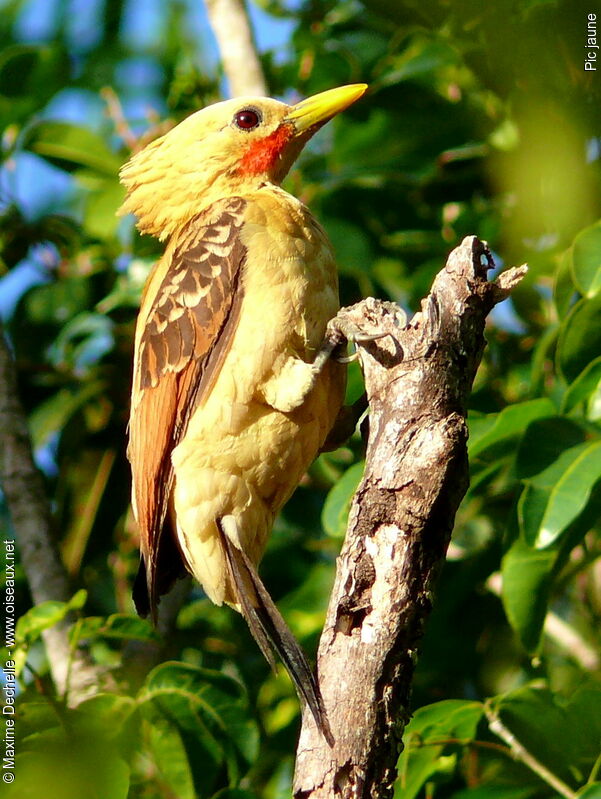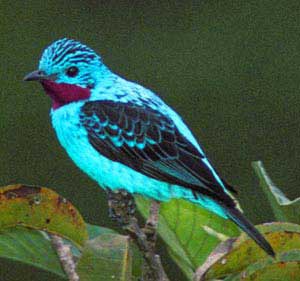Captain's Log, Day 101: Two weeks out of Ecuador, it is dawning on me that I won't, and don't intend to, ever be terribly far from the country again. Though talking to Ernesto, Fabian, and my friends from Yarina and Cuenca over the internet can't hold a candle to actually living in Ecuador with them, I can still be involved from far away. We've been talking a lot at the National Aviary about what we can do to further our connections with Amaru, and how we could expand our conservation efforts in Ecuador....
...for example, our work with Andean Condors. Amaru is being offered two juvenile males to start a breeding and education program, and the Aviary, in hopes of starting such a program anew (we used to have one with Colombia), has acquired a breeding pair from another zoo. Andean condors are extremely endangered in Ecuador, so any help we can provide to their ailing population would make a difference. A breeding program like this, paired with new falconry program and education outreaches by Amaru, could change a lot about how Condors are treated and protected around Cuenca.
 |
| One of the juvenile males who may be moving to Amaru. Thanks for the photo, Ernesto! |
 |
| The day of release for the Andean Condors at the National Aviary! |
 |
| Lurch and Precious are their names. This is Lurch, the male Condor. Check out that cool crest. |
A more pressing concern for Amaru at the moment, though, may be the problems with animal trafficking in Ecuador.
Three new primates. We aren't equipped to be a high-class primate rescue center; we don't have that kind of support. What we really need at Amaru is a way to slow animal trafficking and raptor hunting in the area so that we aren't constantly having to expand our holding areas to accommodate all our new intakes.
2012, Pumapungo has taken in 151 wild birds of 29 wild species, and 23 individuals of 7 "exotic or domestic" species. The majority of these species have been parrots. When you add in Amaru's additional 200-some parrot individuals and dozen raptors acquired in the last year, and consider that this is only Cuenca, and that the vast majority of trafficked animals die in the trade or are released/mistreated to their ends...trafficking is still a huge problem down here.
Below is the species list of all of those trafficked parrot species brought through Cuenca. Credit and thanks to Fabian Toral of the Ecuadorian Ministry of Culture and Patrimony.
During my time in Cuenca, I was able to visit the Centro Commercial with Fabian to see how he goes about seizing trafficked animals. The Centro Commercial is the largest open market in Cuenca, and the majority of the animals seized locally by the ministry are found here.
If you'd like to learn more about animal trafficking or how you can support the direct efforts of Fabian and Ernesto in Ecuador, you can contact me at nbecich@gmail.com. There's a lot of work to be done down there...
Stay tuned for more updates about how Amaru, Pumapungo, and The National Aviary are working together to bolster conservation initiatives in the near future.
Cheers, all.
 |
| She'll need round-the-clock supervision and care for quite a while now. When she was seized out of a bag at the bus station by the ministry, she was completely emaciated. |
 |
| She'll be living with Ernesto's sister here at Amaru. We'll try our best to give her a better home here, but there isn't ever going to be a replacement for what she'd get from her mother in the wild. |
Three new primates. We aren't equipped to be a high-class primate rescue center; we don't have that kind of support. What we really need at Amaru is a way to slow animal trafficking and raptor hunting in the area so that we aren't constantly having to expand our holding areas to accommodate all our new intakes.
 |
| Enter Fabian Toral of Fundacion Mazan and the Environmental Ministry. |
2012, Pumapungo has taken in 151 wild birds of 29 wild species, and 23 individuals of 7 "exotic or domestic" species. The majority of these species have been parrots. When you add in Amaru's additional 200-some parrot individuals and dozen raptors acquired in the last year, and consider that this is only Cuenca, and that the vast majority of trafficked animals die in the trade or are released/mistreated to their ends...trafficking is still a huge problem down here.
Below is the species list of all of those trafficked parrot species brought through Cuenca. Credit and thanks to Fabian Toral of the Ecuadorian Ministry of Culture and Patrimony.
WILD BIRDS
No.
|
Scientific Name
|
Spanish common name
|
1
|
Dendrocygna bicolor
|
Pato Silvón Canelo
|
2
|
Buteogallus meridionalis
|
Gavilán Sabanero
|
3
|
Geranoaetus melanoleucus
|
Aguila Pechinegra
|
4
|
Buteo polyosoma
|
Gavilán Variable
|
5
|
Ortalis guttata
|
Chachalaca Jaspeada
|
6
|
Penelope purpurascens
|
Pava Crestada
|
7
|
Porphyrula martinica
|
Gallareta Purpúrea
|
8
|
Ara ararauna
|
Guacamayo Azuliamarillo
|
9
|
Ara ambigua
|
Guacamayo Verde Mayor
|
10
|
Ara macao
|
Guacamayo Escarlata
|
11
|
Ara severa
|
Guacamayo Frenticastaño
|
12
|
Aratinga erythrogenys
|
Perico Caretirrojo
|
13
|
Aratinga wagleri
|
Perico Frentiescarlata
|
14
|
Aratinga leucophthalmus
|
Perico Ojiblanco
|
15
|
Aratinga weddellii
|
Perico Cabecioscuro
|
16
|
Brotogeris pyrrhopterus
|
Perico Cachetigrís
|
17
|
Brotogeris versicolurus
|
Perico ala de canario
|
18
|
Pionus menstruus
|
Loro Cabeciazul
|
19
|
Pionus sordidus
|
Loro Piquirrojo
|
20
|
Pionus chalcopterus
|
Loro Alibronceado
|
21
|
Amazona autumnalis
|
Amazona Frentirroja
|
22
|
Amazona ochrocephala
|
Amazona Coroniamarilla
|
23
|
Amazona amazonica
|
Amazona Alinaranja
|
24
|
Amazona farinosa
|
Amazona Harinosa
|
25
|
Semnornis ramphastinus
|
Barbudo Tucán – Yumbo
|
26
|
Ramphastos swainsonii
|
Tucán de Swainson
|
27
|
Ramphastos tucanus
|
Tucán Goliblanco
|
28
|
Molothrus oryzivorus
|
Vaquero Gigante
|
29
|
Dives warszewiczi
|
Negro Matorralero
|
Domestic or exotic birds
|
||
No.
|
Scientific name
|
Spanish common name
|
1
|
Anas platyrhynchis
|
Pato doméstico
|
2
|
Pavo cristatus
|
Pavo Real
|
3
|
Nymphicus hollandicus
|
Cacatua Ninfa
|
4
|
Agapornis roseicollis
|
Inseparables Carirrojos
|
5
|
Agapornis personata
|
Inseparable enmascarado
|
6
|
Melopsittacus
undulatus
|
Periquito
Australiano
|
7
|
Paroaria
coronata
|
Cardenal Gris
|
 |
| This little Forpus coelestis would really appreciate anti-trafficking efforts. |
 |
| Because a wild life would likely be a better life. Isn't that right, little guy? As tasty as that quinoa Fabian is feeding you is... |
 |
| Fabian walking towards the market. The picture doesn't do it justice. It's huge. |
 |
| And they sell just about everything you could need or want for your house or farm here. |
 |
| Cuy (guinea pigs), chickens, and other "food" animals were the most visible animals being sold on this side of the market... |
 |
| But there were less identifiable noises coming from other boxes and bags around the large wire cages for the food animals. |
 |
| More identifiably pet-type animals are grouped together regardless of species: here there were dogs, cats, and rabbits in one cage. |
 |
| The cages are often just made of wire, and aren't equipped with water or much feed. Lots of deaths result over the course of a market day under these conditions. |
 |
| I had to take most of the pictures quickly and discreetly from inside my jacket, so apologies for the quality. They hid most of the illegal animals when they heard Fabian was close, anyway. |
 |
| Bags and crates behind cages like these hold the animals that are illegal to sell. This includes all the animals you've seen in my previous Amaru posts... |
 |
| ...but dogs, cats, rabbits, domesticated fowl, exotic birds like budgies and cockatiels are legal to sell. |
 |
| Though there are laws about what you can and can't sell, there aren't too many laws about how you sell aforementioned animals. Few to none of these laws are enforced successfully. |
 |
| Really hard to convey all the noises, heat, waste, and smells...it's just not pretty. |
 |
| The fact that these species are all dwindling dangerously in the wild, though, means that if we don't act they are likely to be lost forever. |
 |
| Fabian and I sure don't want to see them disappear from the Ecuadorian skies. |
Stay tuned for more updates about how Amaru, Pumapungo, and The National Aviary are working together to bolster conservation initiatives in the near future.
Cheers, all.

























